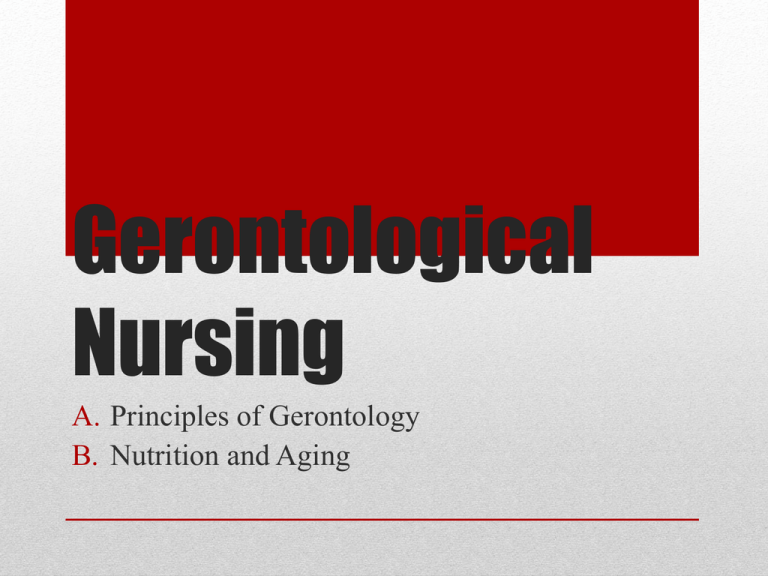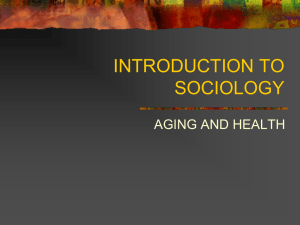Gerontological Nursing
advertisement

Gerontological Nursing A. Principles of Gerontology B. Nutrition and Aging • The terms are not interchangeable! • Gerontology is concerned with the social, psychological, and biological aspects of aging. • Geriatrics is the study of disease in the elderly. Gerontology and Geriatrics 2 • First proposed as a distinct specialty in 1909 by Dr. Ignatz Nascher when he viewed aging as a physiological process and not mere deterioration. • Geriatrics is concerned with the decline of major body systems in the elderly. • A geriatric specialist treats disease in the elderly client and attempts to decrease the effects of aging on the body. Geriatrics 3 • Developed into an organized field in the 1940s. • Acknowledged that there exist experts in the elderly in many fields and findings must be integrated. • Studying the physical, mental and social changes in people as they age • Study of physical process of aging • Study of the effects of the aging population on society and the effects of society on the elderly • Identification of appropriate treatment and management of the elderly Gerontology 4 “You must not treat a young child as you would a grown person, nor would you treat an old person as you would one in the prime of life.” …“Relation of old age to disease…” American Journal of Nursing, 1904 History of Gerontological Nursing 5 • 1935: Federal Old Age Insurance Law • 1961: ANA recommends formation of geriatric nursing specialty • 1966: Geriatric Nursing Division of ANA formed • 1970: Publication of Standards for Geriatric Nursing Practice • 1975: Certification of first nurses in Gerontological Nursing Historical Influences 6 • Aging is a natural process • Various factors influence the aging process • Nursing of the elderly requires unique information and skills • There are common needs shared by the elderly and all ages • Gerontological nursing’s goal is to promote optimum levels of physical, psychological, social and spiritual health Principles of Gerontological Nursing Practice 7 • Holistic: incorporate physical, mental, emotional, and spiritual well being • Use every opportunity to offer suggestions for healthy aging • Include health promotion in every plan of care of the elderly patient • Close the gap between “life span” and “healthy life span” Competent nursing of the elderly patient • • • • Increased creativity and confidence Increased coping ability Increased gratitude and appreciation Increased insight and acceptance Benefits of healthy aging • Responsible for defining scope and standards of nursing practice • Established the Division of Geriatric Nursing Practice in 1966 with the goal of creating standards for quality nursing care for the elderly • Changed the name to Division of Gerontological Nursing Practice in 1976 Role of the ANA in Gerontological Nursing Care 10 • Persons older than 65 comprise 12% of the US population • Increasing life expectancy • 20% of the population will be older than 65 by 2020 The Aging Population 11 • Young-old: 65 to 74 years • Old: 75 to 84 years • Old-old: 85 to 100 years • Elite old: over 100 years Subsets of the Elderly 12 • • • • • Born between 1946 and 1964 Most have children, but fewer in number Best educated generation yet Higher income Favor more casual dress • Enjoy technology • Less leisure time • Interest in health and fitness The Baby Boomers 13 • Adequate nutrition • Maintaining safety • Preserving body’s normal functions • Meeting and coping with crises • Adapting to change • Learning new skills Accomplishments of Old Age 14 • Promotes normalcy, independence and individuality • Reduces risks associated with dependency, e.g., failure to thrive • Recognizes individual attributes of wisdom, experience and competence Recognizing Inner Resources of the Elderly 15 • In 2005, long term health care accounted for 12% of all healthcare expenditure • 70% of this figure was covered by Medicaid and Medicare • 18% was paid by patients and families Associated Costs and Funding 16 • • • • “Old” means being sick Older people cannot learn new information Health promotion is wasted on older people The elderly do not pull their own weight • It is too late to change bad habits in the elderly • Older people have no interest in sex Myths of Aging 17 • Biocognitive Theory (Mario Martinez) • Absence of envy • Live in the present, being optimistic about the present and the future • No sense of aging, don’t tell their age (prevents being “pegged”) • Usually underweight, not obese • Active • No concept of retirement or middle age, no marker for biology to follow Common Characteristics of Centenarians (1) 18 • Rarely seek medical advice unless complaint is significant • Usually die by accident or in sleep…death is peaceful and without lamenting • Low protein, high complex carbohydrate diet • Live in subcultures that revere the elderly • Drink alcohol prudently, not addictively • There are no atheists, a belief in a benign, not wrathful, power Common Characteristics of Centenarians (2) 19 • • • • • • • Longevity in the family is not a requirement Definite sense of humor Forgive easily They are negotiators Have commitment to community, a sense of service Fearless about life’s challenges Believe they are loveable Common Characteristics of Centenarians (3) 20 • • • • • Insight into understanding the process of aging Promote aging in a healthy fashion Postpone or minimize negative effects Emphasis is not on prolonging life Goal is to • Keep the client healthy • Keep the client active • Maximize quality of life Value of Theories of Aging 21 • Biological theories attempt to explain these variations: • Rate of aging varies between individuals • There is variation in rates of aging within one individual Biological Theories of Aging 22 • Premise: life expectancy is inherited due to a genetic program • Cellular theory—senescence takes place at the cellular level • Error theory—decline is caused by genetic mutations within each organ • Failure of a growth substance or excessive production of an aging substance Genetic Theories of Aging 23 • These theories integrate an individual’s • • • • • Mental capacities Methods of behavior Personal feelings Coping mechanisms Values, attitudes and beliefs Psychosocial Theories of Aging 24 • Society and the individual mutually agree to withdraw from one another • The individual is free to become introspective • Society enjoys the benefit of transferring power and resources to the young and continues Is this a “win-win” on an ice floe? Disengagement Theory 25 “I don’t want to!” Disengagement theory problems… 26 • “Longevity through denial” • Perpetuating the middle-age lifestyle • Maintaining an active life while adjusting for biological change • Gradually substitute mental activities for physical ones Activity Theory 27 • AKA Developmental Theory • “PNC”—people never change • Recognizes the unique qualities of each individual • Those qualities guide the individual through the aging process and adaptation to change Continuity Theory 28 • Specific tasks must be completed in each stage of life before moving on successfully • If successful, the person finds meaning in each stage and in life as a whole Developmental Tasks Theory 29 • Coping with loss and change • Establishing meaningful roles • Exercising independence and control • Finding purpose and meaning in life Developmental Tasks Throughout the Lifespan 30 • Adjustment to infirmities • Satisfaction with the life lived • Preparation for death Major Tasks of the Elderly (Robert Butler and Myrna Lewis) 31 • Ego differentiation vs role preoccupation • Body transcendence vs body preoccupation • Ego transcendence vs ego preoccupation All contribute to the effectiveness of completing ego integrity vs despair Specific Challenges of the Elderly (Robert Peck) 32 • Nutritional needs change as the individual ages • Failure to adjust nutrition accordingly can contribute to the aging process Nutrition and aging 33 • Less lean body mass and increased adipose tissue • BMR declines 2% for each decade of life • Activity level usually declines with age Reduced calorie need in the older adult 34 • Age related physical changes: decreased total body water due to less lean body mass • Reduced access to fluids • Fear of incontinence and nocturia • Increased insensitive fluid loss Dehydration risk factors 35 • • • • • • • • • Reduced intracellular fluid with age Reduced margin of safety Minimum 1500 mL per day Reduced thirst sensation Fear of incontinence Decreased availability of fluid Physical impairment Altered mood or cognition GI distress Specific threats to Hydration 36 • Patient may present with altered mental status, lethargy, syncope • Mild dehydration: decreased skin turgor, dry mucous membranes, orthostatic hypotension • Symptoms consistent with mild dehydration may exist in patients who are normally hydrated Signs of early Dehydration 37 • • • • • Dark urine with decreased output Confusion, lethargy Headache, light-headedness Eyes sunken Dry mucous membranes and axillae • Furrows in tongue • Postural changes in vital signs Advanced dehydration 38 • Dark green vegetables, colorful vegetables, dried beans— 2 ½ cups every day • Fresh, frozen, dried, canned fruits— 1 ½ cups every day • Grains—6 ounces every day • Protein foods—5 ounces every day • Dairy—3 cups every day Tufts University MyPlate for older adults 39 • Acknowledges the possible need for supplements • Includes physical activity as part of daily routine • Water is included • Recommendations for protein unchanged Tufts additions to traditional food guide 40 • Sarcopenia—age related loss of muscle mass, strength, and function • Protein breakdown exceed protein synthesis as the body ages • RDA is unchanged: 0.8g/kg body weight Role of protein in the diet of the elderly client 41 • Some elderly clients take supplements for nonconventional reasons • Clotting is affected by fish oils, garlic, ginseng, ginko biloba, baby aspirin • Quality and content of many supplements are neither regulated nor standardized Dietary supplements— nursing considerations 42 • Weight—unintentional loss of 5% in 1 month or 10% in 6 months is significant • Height • Body mass index = (weight in pounds x 703) (height in inches)2 Body measurements (anthropometrics) 43 • Use of Mini Nutritional Assessment (MNA) • “Tell me what you ate yesterday.” • Risk factors: • • • • Inability to feed oneself Chewing, swallowing problems, mouth pain Changes in taste Leaves > 25% food uneaten at most meals Nutritional history 44 • Indigestion, food intolerance—client may chose to use antacids or limit food intake • Have several small meals instead of 3 large ones • Avoid fried foods • Remain in high Fowler’s position for at least 30 minutes • Adequate fluid for motility promotion Strategies to improve nutrition--1 45 • Anorexia • • • • Identify the cause High calorie diet Referral to social programs Psychological/psychiatric referral • Weight loss > 5% in 1 month and >10% in 6 months is significant Strategies to improve nutrition--2 46 • • • • • Polypharmacy Pain Dysphagia Dependency Cognitive impairment Potential causes of anorexia 47 • Dysphagia • • • • Careful swallowing assessment Sit in upright position Allow sufficient time to eat No residual food in mouth before taking additional food • Small portions • Suction machine available • Thickened liquids Strategies to improve nutrition--3 48 • Constipation • • • • • Fluids Fruits, vegetables Activity Increase fiber intake cautiously Consider laxatives only when other methods are unsuccessful Strategies to improve nutrition--4 49 • Imbalanced nutrition—more/less than body requirements (also, “Risk for”) • Impaired swallowing; Risk for aspiration • Excess/deficient fluid volume (also, “Risk for”) • Failure to thrive (adult) • Impaired skin integrity (also, “Risk for”) Nursing diagnoses-nutrition 50



